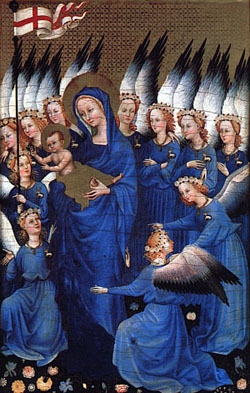Roses in Art
Part I -- Introduction
Throughout art as we know it, roses have been one of the most popular painting subjects used, next to the human form. They can be by themselves, such as a still life, or adorn the object, such as a lady holding a rose or in the background. From the time of the first known rose painting to the present, roses have graced many fine paintings, although largely as an adornment, or with special meaning, rather than by themselves. In this first part of a series, I will concentrate on the use of roses in paintings from ancient times. In other parts of the series, we will cover roses from the Middle Ages, Impressionist times, and today.
The first known painting of a rose is from the fresco found at Knossos, Crete, circa 1500 BC. The archeologists who found the fresco stated that it appeared to be a bird sitting next to a wild rose. Since then, roses have adorned many of the ancient paintings, even though few were of roses themselves. There were some oriental drawings of roses circa the 10th century, but the rose was largely ignored until the Middle Ages. The period from 1050-1200 is often called the Romanesque period of art. The next period is called the Gothic, and it ran from 1150-1500. This showed a marked influence of religion, and roses were used among the paintings as adornments. A drawing circa 1420 showed two sets of lovers standing under roses. Whether they fell under the magic of the roses or were meeting there secretly, we don't know. The best known of the early paintings, which is more of an illustration from a book, was the rose garden scene from Roman de la Rose (circa 1500s).
Roses were often used as adornments in earlier paintings, such as in The Wilton Diptych (circa 1400, artist unknown), where the angels wore roses in their hair garlands and roses were strewn on the ground, or in the background like Stefan Lochner's 1410 painting of the Virgin in the Rose Bower. Piero della Francesca from Italy painted his Madonna and Child with red and white roses in the background, Martin Schongauer painted Virgin in the Rose Arbor (1473), and Durer had roses in his Festival of Rose Garlands (1506). In Durer's painting, the painter, along with Maximilian and the Pope, offer garlands of roses to the Virgin. Before then, only the Virgin Mary was capable of bestowing roses upon her earthly subjects.
Sandro Botticelli was well known for his use of roses in his works, such as in Birth of Venus, where her sweat turned into roses as they fell into the sea. The rose was known as the symbol of Venus, and the rose is the highest honor that the Catholic Church places on an individual. Therefore, roses were predominant in some form in most of the paintings during this period.
In 1461, the rose became a symbol of the British royalty and subsequent paintings of the Queens often showed them holding roses, or with their royal "rose" emblem. In England, roses were appearing in other paintings as well, such as Nicolas Hilliard's A Young Man Among the Roses (1588). In this painting, roses were shown as having thorns. Most of the earlier paintings show roses as thornless.
The time frame 1420 to 1530 was called the Early Renaissance period, and the Northern Renaissance period ran 1500 to 1600. This was a time when classical painting dominated, such as portraits and still-lifes. Roses were used in many of the paintings as adornments once again by such well know painters as Raphael, Leonardo, and Michaelangelo.
The next part of this series will cover the popularity of roses in paintings during the Middle Ages.
Reprinted from Rose Ecstasy, bulletin of the Santa Clarita Valley Rose Society, Kitty Belendez, Editor. This article was an ARS Award of Merit Winner.
© Copyright Steve Jones. All rights reserved.
